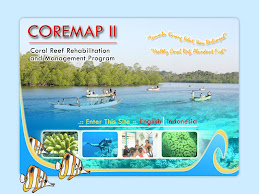
Terumbu karang merupakan rumah bagi 25% dari seluruh biota laut dan merupakan ekosistem di dunia yang paling rapuh dan mudah punah. Oleh karena itu pengelolaan ekosistem terumbu karang demi kelestarian fungsinya sangat penting.
Terumbu karang Indonesia menurut Tomascik, 1997 mempunyai luas kurang lebih 85.707 Km2, yang terdiri dari fringing reefs 14.542 Km2, barrier reefs 50.223 Km2, oceanic platform reefs 1.402 Km2, dan attols seluas 19.540 Km2. Terumbu karang telah dimanfaatkan oleh masyarakat melalui berbagai cara. Akhir-akhir ini penangkapan biota dengan cara merusak kelestarian sumber daya, seperti penggunaan bahan peledak atau zat kimia beracun (potassium sianida) telah terjadi di seluruh perairan Indonesia.
Masyarakat di sekitar kawasan terumbu karang merupakan kalangan yang paling berkepentingan dalam pemanfaatannya, sebaliknya, kalangan ini pula yang akan menerima akibat yang timbul dari kondisi baik maupun buruknya ekosistem ini. Oleh karena itu pengendalian kerusakan terumbu karang sangat diperlukan untuk menjaga kelestarian fungsi ekosistem yang sangat berguna bagi masyarakat pesisir
Terumbu karang merupakan sumber daya alam yang mempunyai berbagai fungsi sebagai habitat tempat berkembang- biak dan berlindung bagi sumber daya hayati laut. Dengan semakin meningkatnya kegiatan pembangunan telah menimbulkan dampak terhadap kerusakan terumbu karang, oleh karena itu perlu dilakukan berbagai upaya pengendaliannya. Salah satu upaya untuk melindungi terumbu karang dari kerusakan tersebut dilakukan berdasarkan kriteria baku kerusakan.
Menteri Negara Lingkungan Hidup telah menetapkan criteria baku kerusakan terumbu karang sebagaimana tertuang dalam KEP MEN LH No. 4 Tahun 2001. Kriteria Baku Kerusakan Terumbu Karang ditetapkan berdasarkan prosentase luas tutupan terumbu karang yang hidup. (pasal 2 ayat (1)), Kriteria Baku Kerusakan Terumbu Karang sebagaimana dimaksud merupakan salah satu cara untuk menentukan status kondisi terumbu karang yang didasarkan pada penggunaan metode Transek Garis Bentuk Pertumbuhan Karang.
KEPUTUSAN MENTERI NEGARA LINGKUNGAN HIDUP NOMOR : 04 TAHUN 2001 TENTANG KRITERIA BAKU KERUSAKAN TERUMBU KARANG, selengkapnya silahkan KLIK DISINI





